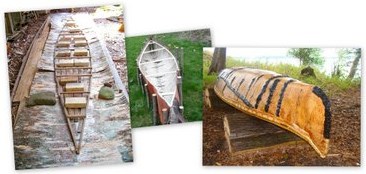THE BIRCH BARK CANOE

The Birch Bark Canoe was the principal means of transportation for Aboriginal peoples of the Eastern Woodlands, and later voyageurs, who used it extensively in the fur trade and in exploring and mapping North America. As the principal means of transportation, it has become an enduring symbol of the wilderness.
 Shooting the Rapids by Frances Anne Hopkins
Shooting the Rapids by Frances Anne Hopkins
When the French arrived in the early 17th century, the intrepid explorers quickly adapted canoes to their own use and soon huge Montreal Canoes laden with beaver pelts were being paddled by teams of voyageurs throughout the northwest of our country.
Why beaver pelts you may ask? Beaver fur was the true currency of the time. Before the invention of the umbrella, beaver pelts were in demand because of their water repellency. But perhaps more importantly, the beaver felt top hat was the fashion de rigueur in all of Europe. So basically, men’s fashion dictated the demand for more furs and the need to explore North America.
 Paris Street; Rainy Day by Gustave Caillebotte
Paris Street; Rainy Day by Gustave Caillebotte
Women played an integral part in the North American fur trade from its inception. The entire fur trade and mapping of North America depended on the participation and labor of Native women for its very survival and economic success. Most fur traders married Native or Mixed-blood women as the relationships strengthened trade ties. Tangible benefits were superb as the “country wife” generally set up camp, dressed furs, made leather, cooked meals, gathered firewood, made moccasins, netted snowshoes, and BUILT AND REPAIRED THE BIRCH BARK CANOES.
 Canoe Building by Women
Canoe Building by Women
Of all the different kinds of bark in the world, only the bark of the birch is capable of sophisticated shaping into elegant and subtle forms. Compared to other trees, the bark of the birch provided a superior construction material, as its grain wrapped around the tree rather than travelling the length of it, allowing the bark to be more expertly shaped. Unlike other bark, birch is smooth, strong, light, resilient and waterproof and does not shrink or stretch.

In building a canoe, bark is stripped from the birch, the white side is placed inside a staked frame, sewn and attached. The frames were usually of cedar, soaked in water and bent to the shape of the canoe. The joints were sewn with spruce or white pine roots, which were pulled up, split and boiled. The seams were waterproofed with hot spruce or pine resin gathered and applied with a stick; during travel, paddlers re-applied resin almost daily to keep the canoe watertight.
Canoe do it? GZ awaits ~ Happy Hunting!